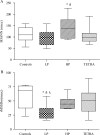Comparison of 24-hour cardiovascular and autonomic function in paraplegia, tetraplegia, and control groups: implications for cardiovascular risk
- PMID: 21903013
- PMCID: PMC3152811
- DOI: 10.1179/2045772311Y.0000000019
Comparison of 24-hour cardiovascular and autonomic function in paraplegia, tetraplegia, and control groups: implications for cardiovascular risk
Abstract
Background: Fluctuations in 24-hour cardiovascular hemodynamics, specifically heart rate (HR) and blood pressure (BP), are thought to reflect autonomic nervous system (ANS) activity. Persons with spinal cord injury (SCI) represent a model of ANS dysfunction, which may affect 24-hour hemodynamics and predispose these individuals to increased cardiovascular disease risk.
Objective: To determine 24-hour cardiovascular and ANS function among individuals with tetraplegia (n=20; TETRA: C4-C8), high paraplegia (n=10; HP: T2-T5), low paraplegia (n=9; LP: T7-T12), and non-SCI controls (n=10). Twenty-four-hour ANS function was assessed by time domain parameters of heart rate variability (HRV); the standard deviation of the 5-minute average R-R intervals (SDANN; milliseconds/ms), and the root-mean square of the standard deviation of the R-R intervals (rMSSD; ms). Subjects wore 24-hour ambulatory monitors to record HR, HRV, and BP. Mixed analysis of variance (ANOVA) revealed significantly lower 24-hour BP in the tetraplegic group; however, BP did not differ between the HP, LP, and control groups. Mixed ANOVA suggested significantly elevated 24-hour HR in the HP and LP groups compared to the TETRA and control groups (P<0.05); daytime HR was higher in both paraplegic groups compared to the TETRA and control groups (P<0.01) and nighttime HR was significantly elevated in the LP group compared to the TETRA and control groups (P<0.01). Twenty-four-hour SDANN was significantly increased in the HP group compared to the LP and TETRA groups (P<0.05) and rMSSD was significantly lower in the LP compared to the other three groups (P<0.05). Elevated 24-hour HR in persons with paraplegia, in concert with altered HRV dynamics, may impart significant adverse cardiovascular consequences, which are currently unappreciated.
Figures



References
-
- Somers VK, Dyken ME, Mark AL, Abboud FM. Sympathetic-nerve activity during sleep in normal subjects. N Engl J Med 1993;328(5):303–7 - PubMed
-
- Elsenbruch S, Harnish MJ, Orr WC. Heart rate variability during waking and sleep in healthy males and females. Sleep 1999;22(8):1067–71 - PubMed
-
- O'Brien E, Sheridan J, O'Malley K. Dippers and non-dippers. Lancet 1988;2(8607):397. - PubMed
-
- Ingelsson E, Bjorklund-Bodegard K, Lind L, Arnlov J, Sundstrom J. Diurnal blood pressure pattern and risk of congestive heart failure. J Am Med Assoc 2006;295(24):2859–66 - PubMed
-
- Verdecchia P, Schillaci G, Gatteschi C, Zampi I, Battistelli M, Bartoccini C, et al. Blunted nocturnal fall in blood pressure in hypertensive women with future cardiovascular morbid events. Circulation 1993;88(3):986–92 - PubMed
Publication types
MeSH terms
LinkOut - more resources
Full Text Sources
Medical
Research Materials
Miscellaneous
